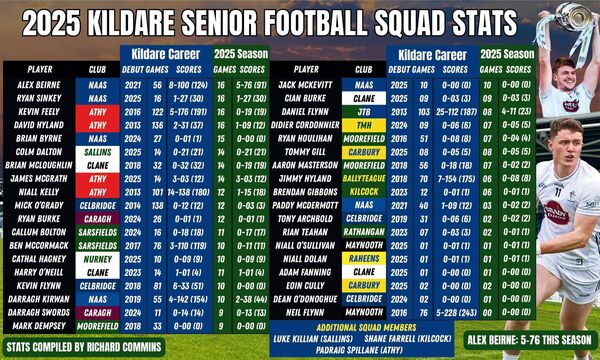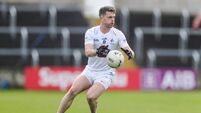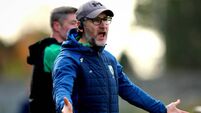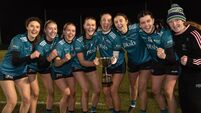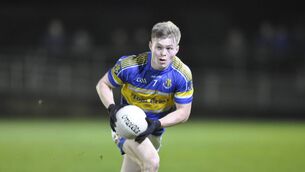Going to plan so far
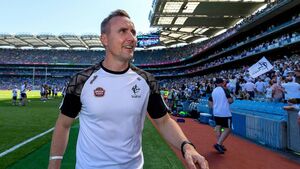
Brian Flanagan has ticked a lot of boxes in his first year in charge and has set a good platform for 2026 Photo: ©INPHO/Tom O’Hanlon
“When it comes to Flanagan’s first year my aspirations would be for us to witness a resurgent pride in the jersey, players taking responsibility on the pitch, and a team that looks organised with a clearly defined and understood way of playing. Each of those would represent progress.”
Those were my hopes for 2025 as set out in these pages in January.
“No matter what Division you are in in the League, you aim to progress, you aim to be promoted in it, but in year one there’s probably a more fundamental thing that we’re going after and that’s making sure we have the best footballers in Kildare available to us, and fit and ready to play when match day comes, and I think that is the number one priority. Get the best players, make sure they’re interested and willing to play and trying to create a culture then and a connection within that group that will serve us much better in year two, three and four.”
Those were Brian Flanagan’s objectives for year one as laid out to the local media last September shortly after his appointment to the senior football manager role.
Given where we’d come from, and no need to go over old ground here, it really was all about, in soccer management parlance, getting back to basics and trying to lay some foundation stones for the remainder of the four-year term that Flanagan insisted on when he agreed to take on the role.
Perhaps worth a reminder of where Flanagan was coming from with that length of term:
“I felt that it was important that the County Board saw it similar to how I see it. I do believe it will take four years to get the team to a point where we can be very competitive again with the top sides in the country. That simplified version is what I want to achieve over the four years.”
While managers will always play down expectations and try not to create a rod for their own back, when looking back on Flanagan’s first year it is important to keep those stated objectives as the bedrock for any reflection, though it is the nature of supporters to want immediate success.
Did Flanagan achieve his goal of having the best players available to him? By and large that has to be a ‘yes’. He convinced David Hyland, Mark Dempsey and Brian McLoughlin back into the fold, managed to retain Kevin Feely and Mick O’Grady for another year, and, most importantly perhaps, proved himself adept at getting buy-in to his inter-county set-up from so many of the under-20 players who passed through his hands previously.
Of course, Flanagan had the advantage of an existing relationship with those boys, and the success that came along at under-20 was clearly helpful, but lads of that age have plenty of other distractions and opportunities.
Flanagan didn’t have access of course to Jack Robinson, Neil Flynn, Darragh Malone, Mark Donnellan or Jack Sargent to name a handful, but those fellas were out the door by and large by the time he came in.
Possibly the only quibble anyone might have with Flanagan on the panel front is whether perhaps the top scorer from the club championship, Aaron Browne, might have warranted a place. He was kept behind in the Development Squad. Perhaps his struggle to make a big impact in two county finals went against the young Celbridge man but another strong club campaign could put him back in the frame.
Flanagan handed out no fewer than ten senior inter-county debuts in 2025. Of those Ryan Sinkey featured in all 16 games, Colm Dalton and James McGrath in 14. All told, the debutants played 86 times. That’s a significant refresh and an influx, in the main, of players who are used to winning.
Having the players available was one thing but having them “fit and ready” was a crucial and telling element of Flanagan’s plan. He brought in Neil Welch from the Sports Injury Clinic in Santry along with Kildare man Dean Ryan and it’s fair to say few observers have been complaining about fitness issues as Kildare generally remained competitive in games that were tight coming down the home stretch, developing a neat habit of winning the majority of those tight games (Westmeath, Offaly, Fermanagh and Limerick being good examples in the championship).
S&C is not a one-year fix, though, and Kildare need to continue focusing on this area to make sure we catch up with the market leaders in both football and hurling.
Resilience was another factor Flanagan spoke about last September, acknowledging that Kildare football had a soft underbelly at times.
“I think we need to build something that is resilient and robust as a team, that can take bad days and take bad moments in a match and overcome them. And players that are of that type of mentality and that type of character that they keep going regardless of what’s put in front of them, regardless of results, that they find a way to overcome it.”
They certainly made advances on that score. There were not unexpected bumps in the road against Clare and Offaly in the League and Louth in the Leinster semi-final, but Flanagan’s Kildare knuckled down and even within tight games in the latter part of the Tailteann Cup managed to come out the right side of results. Not to mention winning twice in succession in Croke Park for the first time in fifteen years.
Whatever he revealed publicly, you can bet your bottom dollar Flanagan had promotion and a place in the Leinster Final written down as goals in that black notebook of his, and while the first was achieved, the Louth defeat will go down as the big disappointment of the year. But the Tailteann campaign gave his panel the chance to develop some of that resilience and a winning culture and mentality that should serve them well.
It wasn’t all sweetness and light of course. There’s still a lot of improvement needed defensively. Given the damage Offaly did in the league and Sligo and Limerick in the Tailteann, Kildare will need to step up their tactics and execution in that area dramatically next year.
There’s also not really a full sense yet of how the team wants to play, but perhaps that’s as much down to the new rules, which bring an element of chaos to kick outs and reduce opportunities for managers to create set patterns of play from the sideline. Players must improvise more, and those traits should be encouraged.
Still, the failure to come to terms with various attacking wing backs (Cormac Egan, Craig Lennon and Tony McCarthy spring to mind), and a general openness down the middle against Limerick the last day, suggest Flanagan may need to bolster his coaching resources over the winter.
There’s also a nagging question mark about our shooting efficiency and whether we have the right approach and focus on two-point opportunities in the new game. The Tailteann final showed the benefit of getting that aspect right.
But those are minor quibbles in a year that has generally gone to plan. Players will come and go next year (Robinson and Flynn would be big additions) but on the whole it will be about consolidation of Division 2 and Sam Maguire status and continuing to mature a young set-up.
Going to plan so far.
